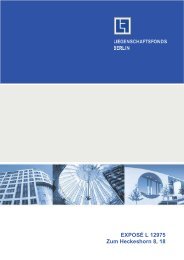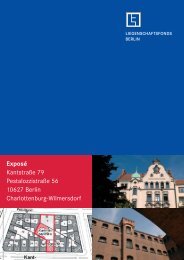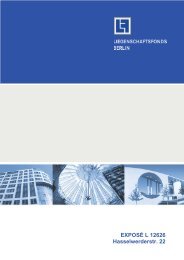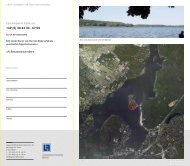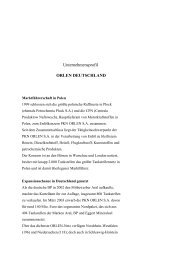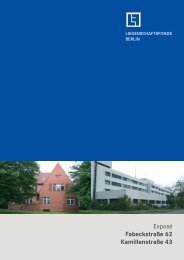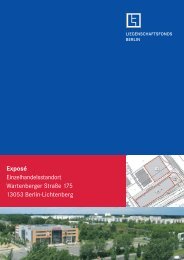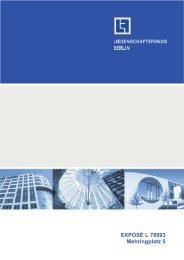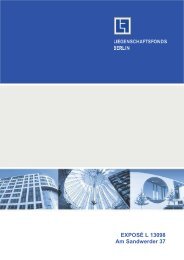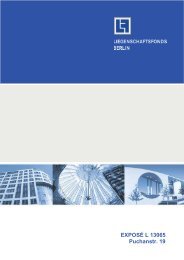Exposé - Liegenschaftsfonds Berlin
Exposé - Liegenschaftsfonds Berlin
Exposé - Liegenschaftsfonds Berlin
Erfolgreiche ePaper selbst erstellen
Machen Sie aus Ihren PDF Publikationen ein blätterbares Flipbook mit unserer einzigartigen Google optimierten e-Paper Software.
3.5<br />
3.5.1<br />
Objektbeschreibung<br />
Location (micro)<br />
Historie<br />
Location (micro)<br />
exposé robert-koch-forum<br />
Der das gesamte trapezförmige Gelände zwischen<br />
Dorotheenstraße und Reichstagufer einnehmende<br />
Komplex für die naturwissenschaftlichen, medizinischen<br />
und technischen Institute der Friedrich-Wilhelms-Universität<br />
(heutige Humboldt-Universität)<br />
ist in den Jahren 1873 – 83 auf Initiative des Physikers<br />
Hermann von Helmholtz errichtet worden. Paul<br />
Spieker, der Architekt der Universitätsbibliothek,<br />
fertigte die Baupläne. Mitarbeiter und Bauleiter waren<br />
K.A.F Zastrau und die Bauinspektoren Hellwig<br />
und Kleinwächter. 1873 – 77 entstanden das Physiologische<br />
Institut an der Dorotheenstraße 96, der<br />
große Hörsaal im Zentrum des Gebäudes sowie die<br />
Direktorenwohnungen an der südwestlichen Ecke.<br />
Die Bauten des Physikalischen Instituts am Reichstagufer<br />
Ecke Wilhelmstraße, 1878 fertig gestellt,<br />
wurden im Zweiten Weltkrieg stark zerstört und<br />
nach 1955 abgetragen. Heute befindet sich an dieser<br />
Stelle das Hauptstadtstudio der ARD. In einer<br />
zweiten Bauphase 1879 – 83 konnten das Pharmakologische<br />
Institut an der Dorotheen-/Ecke Bunsenstraße<br />
und die Institute an der Bunsenstraße<br />
errichtet werden. Weiterer Raumbedarf nach 1900<br />
erforderte die Aufstockung der ursprünglich zwei-<br />
bis dreigeschossigen Bauten. Den Erweiterungsbau<br />
für das Chemische Institut in der Bunsenstraße hat<br />
der Architekt Georg Thür 1907 – 08 den Bauten von<br />
1883 architektonisch angepasst.<br />
Blick auf den Gebäudekomplex, Quelle LDA-Denkmaldatenbank <strong>Berlin</strong><br />
View of the building complex, source LDA-Denkmaldatenbank <strong>Berlin</strong><br />
10<br />
This complex of scientific, medical and technical<br />
institutions belonging to Friedrich Wilhelm University<br />
(now Humboldt University) was built between<br />
1873-83 at the instigation of the physicist Hermann<br />
von Helmholtz. It occupies a trapezium-shaped<br />
area between Dorotheenstraße and Reichstagufer.<br />
Paul Spieker, the architect of the university library,<br />
drafted the plans with assistance and construction<br />
supervision from K.A.F. Zastrau and the building<br />
inspectors Hellwig and Kleinwächter. The Institute<br />
of Physiology at Dorotheenstraße 96, the large<br />
auditorium in the centre of the building and the<br />
university officials’ apartments in the southwest<br />
corner were all built between 1873 and 1877. The<br />
buildings constituting the Institute of Physics at the<br />
corner of Reichstagufer and Wilhelmstraße, built in<br />
1878, were badly damaged during the Second World<br />
War and demolished in the years following 1955. Today<br />
Germany’s first national television channel, the<br />
ARD, has its <strong>Berlin</strong> studio on this site. The Institute<br />
of Pharmacology at the corner of Dorotheenstraße<br />
and Bunsenstraße and several other institutes on<br />
Bunsenstraße were constructed during a second<br />
building phase between 1879-83. After 1900, the<br />
need for more space resulted in more floors being<br />
added onto the originally two- to three-storey buildings.<br />
The extension to the Institute of Chemistry in<br />
Bunsenstraße was designed by Georg Thür in 1907-<br />
08 to match the architecture of 1883.





